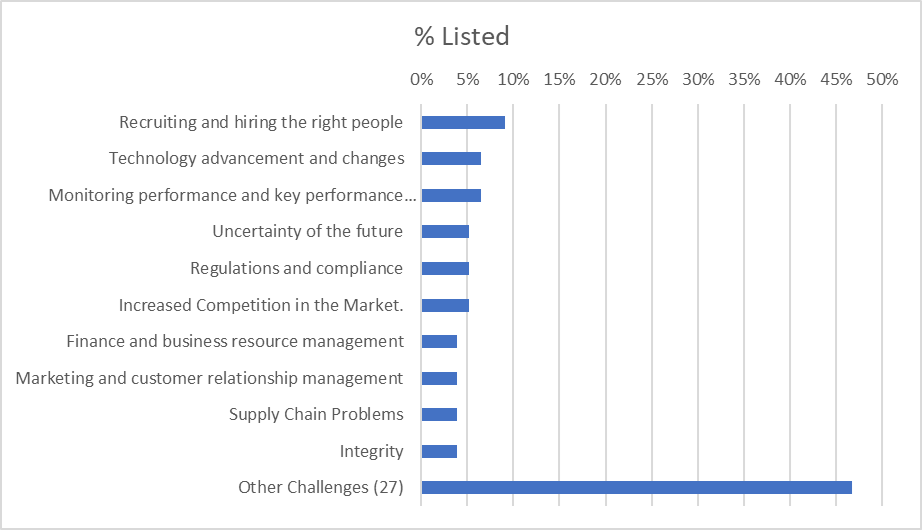If you Google “what’s the biggest challenge in business today,” you get a variety of responses from Google. Oddly, they all contain a number. “7 Biggest Challenges…33 Biggest…10….5….6….8….and so on.”
Business people like numbers.
While business people understand there’s always more than one challenge, which story Google delivers is the one to read or believed?
One publisher friend called the technique of using number in a headline “click bait” to get Google to find it and put it in the search deliverable set on page one.
I used the number 77 because of a technique I learned a long time ago: compiling. Here’s what I did.
Questioning the Questions
I asked myself after seeing what Google delivered, “But what IS the one biggest challenge?” Further, “Is the ONE hiding within the 33 or 7 or 6 or…?”
As it turns out, when you compile all the stories on page one into a single spreadsheet, there are 77 challenges facing business today according to these authors, which can be aggregated into 37 challenges (some are repeated in the lists).
However, no one challenge appeared on all the lists! In fact, a challenge would never be listed more than 9% of the time!
Perhaps it depends on who is drawing up the list!
Challenges, Like Beauty, Appear to be in the Eye of the Beholder
So, before I tell you what the one challenge is and always has been for business, here’s the compiled list of challenges from the stories on page one that Google delivered.
List of Lists

Actually, the top ten challenges from the 11 stories (see NOTES on the end of this story for the original story content) weigh in fairly evenly in terms of the number of times that challenge gets listed in half the chart.
10 challenges comprise 50% of the chart and the other 27 challenges in the other half (in total, there are 77 challenges listed, some more than once, i.e., uncertainty of the future).
“Recruiting and hiring the right people” in our own research has always been an ongoing top complaint (challenge). Perhaps today more than ever, it still is[1]. You are hearing most recently about how virtually all companies can’t find enough workers to meet their demand.
Other challenges like technology moving too fast or managing the supply chain have also been around awhile.
Challenges spring up everywhere at different times, are solved, disappear only to spring up again. And again.
Any business owner will tell you this: challenges are the cycle of business life.
However, these “challenges” are really springing from the root cause of all business problems, which is: finding and retaining customers. Here’s why that’s the number one business challenge.
Root Cause
Without customers, a business doesn’t exist. Therefore, finding and retaining them is at the root of all other business challenges. The list of “challenges” from the grid are tactics that address the root problem. If you don’t have the right people, you will lose customers. If you don’t have technology to support your customers, you will lose them to others who do. If you can’t get the right part to your customer when he needs it, you will lose that customer to your competitor. Etc. Etc.
Besides, things change constantly and keeping up with changes (i.e., technology) is always a challenge in itself! But, the question is still always, how do any of these help you gain and retain customers?
Giving Them What They Want
Many years ago, when I broke into copywriting, I was fortunate to work for Bill Robinson. Bill (way before I met him) traveled the country with Jack Dempsey, the famous boxer, pitching enrollment in DeVry schools. Bill was an expert copywriter, semi-retired when I ran into him. He taught me valuable advice, the most valuable being: “Give ‘em what they want.”
When I asked him, “But what about what they need?” Bill said, “Forget it. Most people don’t know what they need, but they all know what they want. If you are going to succeed in this business, give them what they want.”
It took a couple of years to get that, but once it penetrated, it became the core of why my company has lasted 31 years.
Finding and Retaining Customers
The customer will come back if you have given them what they want. The customer will leave if you don’t.
It’s that simple – and that complicated. Because today, with the Internet, there are vast amounts of choices available to each and every customer. The biggest challenge, therefore, is not just finding customers and keeping them, but finding out what they want.
Because they seem to want everything.
Of course, everything depends on what you are selling. Or what the customer wants.
Need Versus Want
At High Point Market several years ago, Don Tickle, one of the greatest salesmen that I ever met, was walking through a massive building filled with fabric, furniture, everything you could desire if you are an interior designer. High Point was for the trade only and it was my first experience at the event.
Don suddenly turned to me and said with a gleam in his eye, “Jim, do you see anything you need?” He smiled.
In that moment, I realized something important that brought Bill Robinson back to mind: It’s not about what you need. It’s about what you want.
High Point Market offered designers a wealth of things they could offer their clients. What that client “wanted” was as yet unknown. Therefore, the designer sought exposure to all of that “stuff” to give them the advantage when confronting clients on what a client wanted.
Any business is in that business of giving people what they want – not what they need.
Remember toilet paper shortages?
Everyone wanted toilet paper. You could argue they needed it, but seriously, how much do you need? Even big box retailers like Costco couldn’t keep up with what customers wanted.
Bidet seat sales shot through the roof. One plumbing contractor we interviewed in Kansas bought up all the bidet seats he could on Amazon as well as his local distributors and sold them at a sharp profit.
That was innovation based on giving people what they want.
The whole idea then is figuring out what a customer wants – and then giving it to them.
That is the true challenge of a business.
And the real challenge today, with COVID-19, is that it is hard to figure out what you really want if you are a customer.
Or a business.
But, the formula has never changed: if you give people what they want, they will come back. If you don’t, they won’t.
The journey continues, doesn’t it? Tell me what you think YOU want?
______________________________________________
NOTES: Where the Lists Came From:
https://maxmyprofit.com.au/blog/7-biggest-challenges-facing-your-business/
https://mariopeshev.com/the-biggest-business-challenges-growing-companies/
https://www.entrepreneur.com/article/362771
https://www.investopedia.com/articles/pf12/small-business-challenges.asp
https://www.youngupstarts.com/2019/03/12/the-6-biggest-challenges-businesses-face-today/
https://www.advisorpedia.com/growth/8-biggest-challenges-businesses-face-today/
https://theusatwork.com/the-10-biggest-challenges-businesses-faced-in-2020/
https://www.businessblogshub.com/2019/10/what-will-the-biggest-challenges-be-for-businesses-in-2020/
https://www.indeed.com/career-advice/career-development/challenges-businesses-face
____________________________________________________________________
[1] McKinsey Global Institute (MGI), who knows about these things, produced a 152-page report called, “The future of work after COVID‑19” and pointed out many aspects of the challenge of hiring and finding the right people. Among them were three trends: 1) the acceleration of hybrid remote work– four to five times the level before the pandemic and may reduce demand for mass transit, restaurants, and retail in urban centers; 2) the growth in share of e-commerce and the “delivery economy,” which was two to five times faster in 2020 than before hastening the decline of low-wage jobs in brick-and-mortar stores and restaurants, while increasing jobs in distribution centers and last mile delivery; and 3) enlisting automation and AI to cope with COVID-19 disruptions, putting more robots in manufacturing plants and warehouses and adding self-service customer kiosks and service robots in customer interaction arenas. Indeed, the report said that faced with a shortage of tech talent, companies like IBM, Bosch, and Barclays started apprenticeship programs to recruit and train workers from nontraditional backgrounds for roles. As with all MGI research, this report is independent and has not been commissioned or sponsored in any way by business, government, or other institution.

I just got to your article and in typical fashion enjoyed your thoughts. Very succinct and a helpful reminder to unclutter our excesses of thought. Keep it up!
Tom, really happy to got a chance to read and comment. Always appreciate your own insights!
Jim, I always felt the largest challenge was building the strongest possible relationship with your customers. Understanding the customer’s goals (wants) for the year, helps you craft your product to the “wants” the customer and if you hit a grand slam, needs as well.
Larry, we’re singing from the same hymn book. Forging new customers and retaining them is centered on the relationship. Thanks for reading and commenting, and let’s talk soon.
Just heard from a good friend, Tony B. on the article via email: “Nicely written as always, concise and straightforward. The TP analogy was a perfect fit to explain your crafted words. In baseball Wee Willie Keeler said “hit ’em where they ain’t”. Just makes plain sense. Give the customer what they want! I just wrote it on a piece of paper on my desk until it is forever engrained in my thought processes.” Thanks so much Tony…stay safe!
Jim, thanks for sharing this valuable observation with me. We’ve heard it all before over decades and decades, but someone like you needs to remind people that successful businesses are successful at addressing the wants of their clients first. All good things follow that rule. Napoleon Hill, W. Clement Stone, Tom Peters and many brilliant people have proven it out over the years. As always, you zero in on genuine value. My best to you, friend. Gary
Gary, always appreciate your comments! I appreciate your own wisdom, from which I have gained in my association and friendship with you in the Cornerstone meetings we held in the past. Once thing COVIOD-19 can’t take away — the relationships formed during sessions like you conducted. Thanks again.